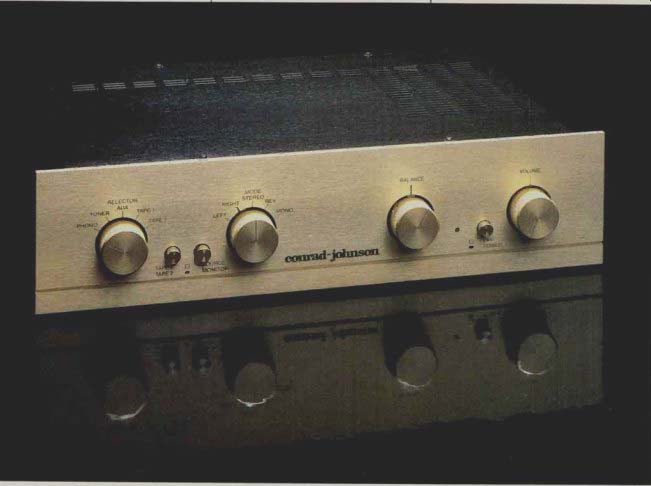
Company Address: 1474 Pathfinder La., McLean, Va. 22101, USA.
The choice between tube and transistor preamps is increasingly hard to make. In the past, transistors offered extended frequency response and amplitude linearity, but usually lacked the natural and upper-midrange detail, life, and sweetness of their tube counterparts. Tube preamps, however, often sounded warm. They lacked the extended highs and deep, tight bass of the better transistor units, and sometimes lacked their speed in handling bass and lower-midrange transients.
During the last two years, transistor units have begun to acquire many of the merits of tube units, and vice versa.
The best preamps of both types now differ more in nuance than in predictable strengths and weaknesses.
The conrad-johnson PV-5, however, makes a good case for the continued superiority of the best tube units. It is remarkably linear in frequency response and is extended in the lows and the highs. It has excellent detail regardless of whether the music has the fine harmonic structure of a soft chamber group or the complex imaging and dynamics of a full orchestra. At the same time, it has the superb midrange traditional with the best tube preamps.
If this sounds like high praise, it should. The conrad-johnson PV-5 does not quite equal the company's top-of-the-line Premier Three, but it comes close. The differences are subtle: The PV-5 has less ability to resolve fine harmonic detail and also has a slightly less sweet and natural upper four octaves.
The PV-5 may lack the upper octave transient detail of the Audio Research SP-10, or the superior high-frequency extension of the Audio Research SP-8, but many listeners are likely to prefer the warmth of its lower midrange and its ability to give musical life to the many records and Compact Discs with slightly hard treble and upper midrange.
The PV-5 is not perfectly neutral (no piece of audio equipment is), but it approaches the state of the art. I have used it with a wide variety of top-ranking components, including the conrad-johnson Premier Four and the Audio Research D-160B amps and the Quad ESL-63, Thiel CS3, and Fuselier 3+3 speakers. In each case, the PV-5 emerged as remarkably uncolored, even in comparison with preamps costing twice its price.
This lack of coloration is particularly clear on phono sources. The PV-5 brings the best out of the best records.
Imaging is stable and natural. There is good center-fill and depth, but the sound still extends slightly to the left and right of each speaker.
The PV-5 approaches the Premier Three and SP-10 in showing just how much detail is hidden in direct-to-disc recordings. Not only is it relatively uncolored, it is remarkably quiet for a tube unit. This may result from its twin triode configuration, its regulated d.c. filament supply, from the choice of tubes, or simply from good execution of design. Nevertheless, it is possible to use many of the higher output moving coils like the EMT, Koetsu, and Alpha-1 without a pre-preamplifier.
This will involve some sacrifice of dynamics and timbre, but it is still an achievement that some tube preamps are too noisy to allow.
The PV-5 is also a convenient preamp to use. It is a "basic" preamp and lacks tone controls and the convenience of a built-in, high-gain stage for moving coils, but it has a full range of input options, including the controls to use two tape decks. It provides a mode control with a choice of mono, stereo reverse, left, and right-something sadly missing on some high-end preamps. The rest of its controls have a good "feel" and allow for easy adjustment of gain and balance without having to keep the controls at extremes or fuss with very small movements.
In summary, the PV-5 comes close to being a $3,000 to $4,000 preamp at a price of $1,485. If you are committed to tubes, Audio Research and Counterpoint offer strong competition in this price range, and I would still recommend that you audition top-ranking units such as the Audio Research SP 10 or conrad-johnson Premier Three. If you prefer the transistor competition, I suggest auditioning the Krells, Thresholds, or Levinsons. Money still buys more than a brand name and a faceplate. In any case, the PV-5 is undoubtedly one of the best preamps around.
-Anthony H. Cordesman
(Audio magazine, Aug. 1984)
Also see:
Conrad Johnson Premier Five Amplifier (Aug. 1986)
Conrad-Johnson Premier Seven-A Preamp and Evolution 2000 Amp (Jun. 1992)
Yamaha CD-X1 Compact Disc Player (Aug. 1984)
= = = =